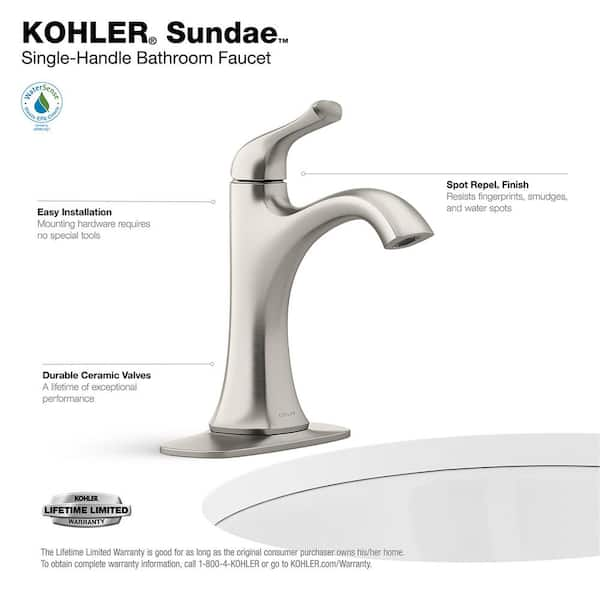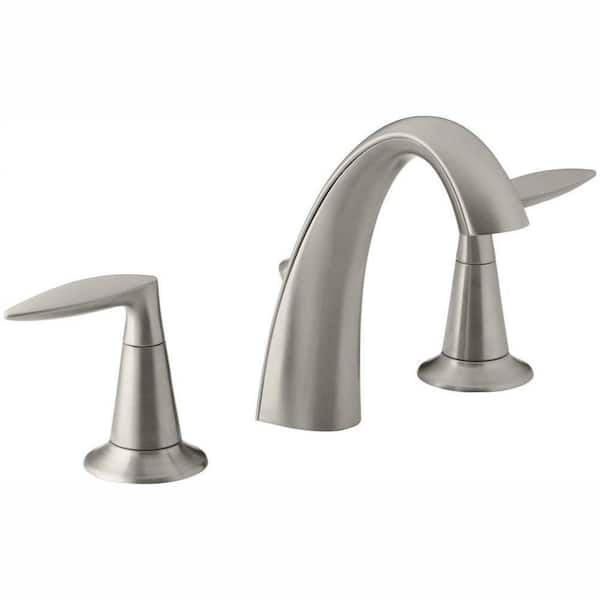The Importance of a Flow Restrictor in Kohler Bathroom Faucets
When it comes to bathroom faucets, one component that often goes unnoticed is the flow restrictor. However, this small device plays a crucial role in conserving water and maintaining the overall functionality of your Kohler bathroom faucet. I will explain why the flow restrictor is important and how it contributes to more sustainable and efficient water usage in your bathroom.
- Water Conservation: The flow restrictor in Kohler bathroom faucets is designed to limit the amount of water that flows out of the faucet. By reducing the flow rate, it helps conserve water and promotes responsible water usage. This is especially important in areas where water scarcity is a concern or for households looking to reduce their water consumption.
- Cost Savings: By using a flow restrictor in your Kohler bathroom faucet, you can also save money on your water bills. With a lower flow rate, less water is used, resulting in lower water bills over time. This is not only beneficial for your wallet but also for the environment, as it reduces the demand for water resources.
- Extended Lifespan: Another important aspect of the flow restrictor is that it helps protect the internal components of your Kohler bathroom faucet. By regulating the water flow, it prevents excessive pressure and strain on the faucet, which can lead to leaks, drips, or other damage. This means that by using a flow restrictor, you can potentially extend the lifespan of your faucet and avoid costly repairs or replacements.
- Environmental Impact: The flow restrictor in Kohler bathroom faucets is part of a broader effort to promote sustainability and reduce our environmental impact. By conserving water, we are helping to preserve this precious resource for future generations. Additionally, using less water also reduces the energy required to treat and distribute water, further minimizing our carbon footprint.
- Compliance with Water Conservation Regulations: Many regions have implemented water conservation regulations that require the use of flow restrictors in faucets. By installing and maintaining a flow restrictor in your Kohler bathroom faucet, you ensure that you comply with these regulations. This not only avoids potential penalties but also demonstrates your commitment to being a responsible water user.

Understanding How a Flow Restrictor Works in Kohler Bathroom Faucets
To fully appreciate the importance of a flow restrictor, it is essential to understand how it works within the context of a Kohler bathroom faucet. Here is a brief overview of the inner workings of a flow restrictor in Kohler bathroom faucets.
- Flow Restriction Mechanism: The flow restrictor is typically a small disc or screen located at the end of the faucet spout or within the aerator. It works by narrowing the pathway through which water flows, thus reducing the flow rate. The restrictor is designed to allow a predetermined amount of water to pass through, ensuring a controlled and efficient flow.
- Water Pressure Regulation: One of the key functions of a flow restrictor is to regulate water pressure. By restricting the flow, it helps maintain consistent and moderate pressure, preventing excessive force that could damage the faucet or cause splashing. This ensures a smooth and comfortable water flow for everyday use.
- Water-Saving Design: Kohler bathroom faucets are engineered with water-saving features, and the flow restrictor plays a vital role in this design. By limiting the flow rate, the restrictor helps achieve the desired balance between water conservation and optimal performance. It allows you to enjoy a sufficient amount of water for daily activities while minimizing waste.
- Customizable Flow Rate: In some Kohler bathroom faucets, the flow restrictor can be adjusted or removed to customize the flow rate according to personal preference. This flexibility allows individuals to find the perfect balance between water conservation and their specific needs. However, it is important to note that adjusting or removing the flow restrictor may affect the faucet’s compliance with water conservation regulations.
- Maintenance and Cleaning: Over time, mineral deposits and debris can accumulate on the flow restrictor, affecting its performance. Regular cleaning and maintenance are necessary to ensure the flow restrictor operates optimally. This can be done by removing the aerator or flow restrictor and soaking it in a solution of vinegar and water to dissolve the deposits. Proper maintenance will ensure a consistent and efficient water flow from your Kohler bathroom faucet.
Benefits of Using a Flow Restrictor in Kohler Bathroom Faucets
Using a flow restrictor in your Kohler bathroom faucet offers numerous benefits that go beyond water conservation. Let me highlight some of the key advantages of incorporating a flow restrictor into your bathroom routine.
Water Conservation: The primary benefit of using a flow restrictor is water conservation. By limiting the flow rate, you can significantly reduce your water consumption without compromising the functionality of your Kohler bathroom faucet. This contributes to a more sustainable lifestyle and helps protect our planet’s precious water resources.
Cost Savings: As mentioned earlier, installing a flow restrictor can lead to cost savings on your water bills. By using less water, you can expect a noticeable reduction in your monthly expenses. Over time, these savings can add up, making a flow restrictor a wise investment for your home.
Environmental Responsibility: Conserving water is an essential aspect of environmental responsibility. By using a flow restrictor, you are actively participating in water conservation efforts and reducing your carbon footprint. This small change in your bathroom routine can have a significant impact on the environment.
Enhanced Faucet Performance: Contrary to the misconception that flow restrictors hinder faucet performance, they actually help maintain a consistent and controlled water flow. By regulating the flow rate, the restrictor ensures a smooth and comfortable water experience, preventing splashing or excessive force.
Compliance and Longevity: Many regions have regulations in place that require the use of flow restrictors in faucets. By using a flow restrictor in your Kohler bathroom faucet, you ensure compliance with these regulations. Additionally, the flow restrictor helps protect the internal components of your faucet, potentially extending its lifespan and reducing the need for repairs or replacements.
How to Remove or Adjust the Flow Restrictor in a Kohler Bathroom Faucet
If you are looking to remove or adjust the flow restrictor in your Kohler bathroom faucet, this section will guide you through the process. Please note that removing or adjusting the flow restrictor may affect the faucet’s compliance with water conservation regulations, so proceed with caution.
Gather the Necessary Tools: Before starting, gather the tools you’ll need, such as pliers, an adjustable wrench, a cloth or towel, and a container to catch any water that may spill during the process.
Locate the Flow Restrictor: The flow restrictor is typically located at the end of the faucet spout or within the aerator. Depending on your Kohler bathroom faucet model, you may need to remove the aerator first to access the flow restrictor.
Remove the Aerator: To remove the aerator, wrap a cloth or towel around the aerator, then use pliers or an adjustable wrench to unscrew it counterclockwise. Be careful not to apply excessive force to avoid damaging the faucet or aerator.
Identify the Flow Restrictor: Once the aerator is removed, you should be able to see the flow restrictor. It is usually a small disc or screen located at the end of the aerator.
Remove or Adjust the Flow Restrictor: To remove the flow restrictor, gently pry it out using a flathead screwdriver or your fingernail. If you prefer to adjust the flow rate instead, you can use a small drill bit or a pin to enlarge the holes in the flow restrictor. Remember to make small adjustments and test the flow rate after each modification.
Reassemble the Faucet: After removing or adjusting the flow restrictor, reassemble the faucet by screwing the aerator back onto the faucet spout. Use a cloth or towel to protect the aerator from scratches while tightening it with pliers or an adjustable wrench. Ensure that the aerator is securely attached, but avoid overtightening, as it may cause damage.
Troubleshooting Common Issues with Flow Restrictors in Kohler Bathroom Faucets
While flow restrictors in Kohler bathroom faucets are designed to enhance water efficiency and functionality, they may occasionally encounter issues. Let’s address some common problems that you may encounter with flow restrictors and provide troubleshooting tips to help resolve them.
Low Water Pressure: If you notice a significant decrease in water pressure after installing a flow restrictor, it could indicate a clogged or partially blocked restrictor. To resolve this issue, remove the aerator and flow restrictor, then clean them thoroughly by soaking them in vinegar and water solution. Use a soft brush or toothbrush to remove any debris or mineral deposits. Once cleaned, reassemble the faucet and test the water pressure.
Uneven Flow: Sometimes, a flow restrictor can cause uneven water flow, resulting in splashing or erratic water distribution. This issue is often caused by a misaligned or partially clogged restrictor. Disassemble the aerator and flow restrictor, clean them carefully, and ensure that the restrictor is properly aligned with the aerator. Reassemble the faucet and test the water flow to check if the issue has been resolved.
Excessive Splashing: If you experience excessive splashing when using a flow restrictor, it may be due to an improperly sized restrictor or an aerator that is not compatible with the flow restrictor. In such cases, consider replacing the flow restrictor with a different size or a different aerator that is specifically designed to work with flow restrictors. This will help ensure a smoother water flow without excessive splashing.
Inconsistent Temperature: In some cases, the installation of a flow restrictor can lead to fluctuations in water temperature. This issue may occur if the restrictor is affecting the balance between hot and cold water flow. To address this problem, try adjusting the flow restrictor or removing it altogether to see if it resolves the temperature inconsistency. If the issue persists, it may be necessary to seek professional assistance to ensure proper water temperature regulation.
Compliance Concerns: If you are experiencing issues with your flow restrictor and suspect it may not comply with water conservation regulations, it is important to verify the specific requirements for your region. Check with local plumbing codes or consult a professional plumber to ensure that your flow restrictor meets the necessary standards. They can offer guidance on potential solutions or recommend alternative flow restrictor options that comply with regulations.
Seek Professional Assistance: If you have attempted troubleshooting steps and are still encountering issues with your flow restrictor, it is recommended to seek professional assistance. A licensed plumber will have the expertise and knowledge to diagnose and resolve any complex problems with your Kohler bathroom faucet’s flow restrictor. They can also guide proper maintenance and ensure that your faucet is functioning optimally.
Kohler K-1031237-BN Aerator, Vibrant Brushed Nickel
KOHLER Alteo 8 in. Widespread 2-Handle Water-Saving Bathroom
How To Fix A Kitchen Or Bathroom Faucet With Low Water Flow Pressure
KOHLER K-1054432 Kit Aerator, 1.5 Gpm
How To Fix Low Water Pressure From a NEW Pullout Kitchen Faucet
1.2GPM Faucet Replacement Part Insert Filter, Restrictor Aerator
Remove Moen Kitchen Faucet Flow Restrictor – Moen Align Faucet shown – Easy way to get better flow!
Related Posts:
- Essence 8 In Widespread 2 Handle Low Arc Bathroom Faucet
- Belmont 4 In Centerset 2 Handle Bathroom Faucet In Chrome
- Moen Rubbed Bronze Bathroom Faucets
- Change Washer Bathroom Faucet
- Hands Free Commercial Bathroom Faucets
- Bathroom Faucets White Finish
- Compare Bathroom Faucet Brands
- How To Connect Garden Hose To Bathroom Faucet
- Kingston Brass Wall Mount Bathroom Faucet
- How To Replace Moen Two Handle Bathroom Faucet Cartridge










